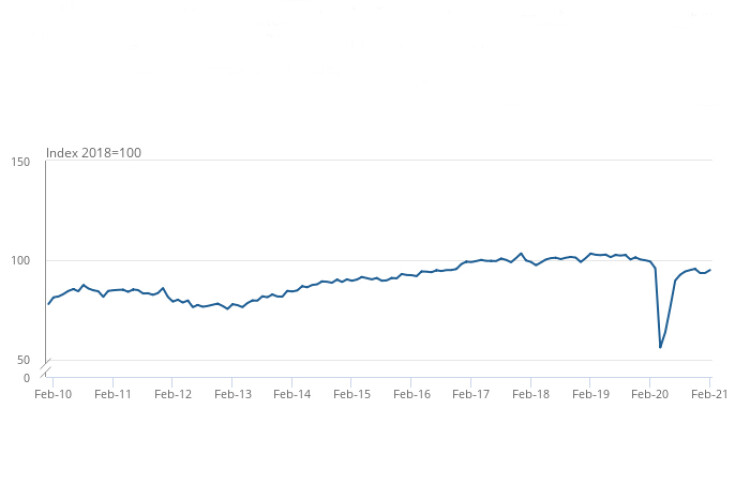February 2021 construction output reached £13,319m, according to latest Office for National Statistics estimates, an increase of 1.6% on January 2021.
January’s output, previously estimated to have been 0.9% up on December, has now been revised to show 0.0% growth. 2020 annual construction growth has also been revised – down 1.5 percentage points to an annual decline of 14.0%;
Despite February’s growth, it remained 4.3% (£598m) below its February 2020 pre-pandemic level.
The increase in February’s total output comprised a 1.5% increase in new work and a 1.9% increase in repair & maintenance.
New work was 7.8% below the February 2020 level, but repair & maintenance was 2.2% above it.
The monthly increase in new work (1.5%) in February 2021 was because of growth in all new work sectors apart from infrastructure, which fell by 3.4%. The largest contributor to this growth was private commercial new work, which grew by 4.0%.
The monthly increase in repair & maintenance (1.9%) in February 2021 was because of growth in private and non-housing repair and maintenance, which grew by 4.7% and 2.6% respectively, offsetting the 8.6% fall in public housing repair and maintenance.
Construction output fell by 1.0% in the three months to February 2021 compared with the previous three-month period, because of a 1.6% fall in new work and 0.1% fall in repair and maintenance.

Commenting on the data, Beard finance director Fraser Johns said: “There is a lot of optimism around this week, and rightly so with the reopening of our retail sector and a successful vaccine rollout.
“The highest level of growth month-on-month since September at 1.6% certainly provides hope that we are heading in the right direction in terms of a roadmap out of the crisis. And compared to the rate of growth of the economy overall at 0.4%, the construction sector has performed well.
“However, in the three months to February output actually fell by 1% and the month was 4.3% down on the same point last year. We also had the warning from the Construction Leadership Council last week that shortages of building products and materials are set to get worse before they get better.
“So, while the rate of growth we see from today’s figures provides a welcome shot in the arm for the construction industry, it’s more important than ever to ensure good relationships with suppliers, including adherence to the prompt payment code. This will help to create the solid foundations needed for growth this year.”
Clive Docwra, managing director of property and construction consultancy McBains, said: “Today’s figures are another sign that construction industry is maintaining its recovery following the downturn over the last year. Confidence is still fragile in some work sectors, but there’s a definite feeling of the glass being half full, rather than half empty.
“Especially cheering is the growth in private commercial new work, which grew by 4%, suggesting that order books are beginning to be filled on a more regular basis. Projects in many sectors have been paused while lockdown measures have been in place, but the lifting this week of restrictions in retail, hospitality and leisure will hopefully also kick-start investment in construction within these industries.
“Recovery will be a long haul however, as output still remains more than 4% below pre-pandemic levels. One factor that could further affect the recovery are reports of materials shortages. Cement, timber and steel are already in short supply, and where products like these are imported from countries experiencing surges in Covid cases, it’s having a particular impact.”
The Federation of Master Builders (FMB) repeated its call for government commitment to a long-term national retrofit strategy to support industry growth. Chief executive Brian Berry said: “Spring has brought green shoots of recovery in the construction sector, with a 1.6% monthly rise in output in February. While still below its February 2020 level, steps on the path to recovery are welcome after an incredibly difficult year. The repair, maintenance and improvement (RMI) sector has done particularly well, with output 2.2% higher than this time last year, before lockdown began. But following the premature closure of the Green Homes Grant scheme last month, this boost for local builders needs to be secured and maintained. The government has the opportunity to boost regional construction activity through the introduction of a national retrofit strategy. Such a strategy would give local builders the long-term confidence they require to invest in their skills, take on new employees, and support the UK’s transition to net zero by 2050. In the year of the United Nations COP conference, the announcement of a long-term national retrofit strategy would demonstrate the UK government to be leading on the climate emergency, while supporting this country’s local builders in parallel.”
Got a story? Email news@theconstructionindex.co.uk



